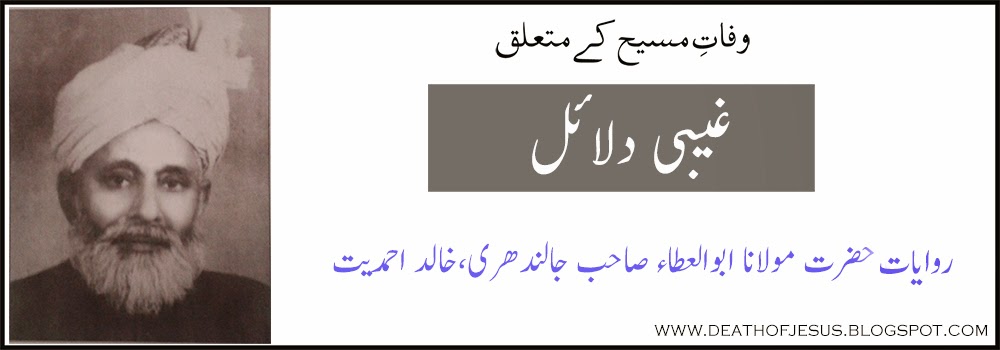Download These Images in .jpeg HERE
بسم اللہ الرحمٰن الرحیم

دوران تبلیغ اکثر داعیان الی اللہ اور مبلغین کا یہ ذاتی تجربہ ہے کہ بسا اوقات دوران تبلیغ اللہ تعالیٰ فوراً دل میں کوئی نقطے کی بات ڈال دیتا ہے ۔جو بسا اوقات بہت سادہ اور معمولی ہوتی ہے لیکن بہت ہی کارگر اور مسکت ثابت ہوتی ہے ۔خالد احمدیت حضرت مولانا ابوالعطاء صاحب جالندھری روایت کرتے ہیں کہ :
''فلسطین میں ایک موقعہ پر نابلس کے چند استاد تبلیغی گفتگو کے لئے آئے۔احمدیہ دارالتبلیغ میں اس وقت آپ کے علاوہ چند احمدی بزرگ بھی موجود تھے ۔وفات مسیح کا ذکر ہو رہا تھا ۔غیر احمدی عالم نے کہا کہ اگر حضرت مسیح ؈واقعی فوت ہو چکے ہیں تو ان کی قبر کہاں ہے ؟انہیں بتایا گیا کہ تاریخی شواہد سے ثابت ہے کہ ان کی قبر سری نگر ،کشمیر میں ہے ۔کشمیر کا نام سن کر بے اختیار ان میں سے ایک کی زبان سے نکلا کہ اتنی دور!یہ کیسے ہو سکتا ہے ؟آپ فرمایا کرتے تھے کہ ابھی میں نے انہیں کوئی جواب نہ دیا تھا کہ ہمارے مرحوم بھائی علی القزق جو معمولی تعلیم یافتہ تھے نے جھٹ فرمایا کہ کیا کشمیر آسمان سے بھی دور ہے ؟ یہ برجستہ جواب سن کر وہ غیر احمدی عالم اور باقی سب اساتذہ لاجواب ہو گئے ۔''
''وفات مسیح ہی کے ضمن میں ربوہ ؔکا ایک واقعہ بہت دلچسپ ہے ۔چند غیر احمدی علماء ربوہ میں آئے ۔احمدی علماء کرام سے وفات مسیح کے موضوع پر بہت تفصیلی بات چیت ہوئی ۔متعدد قرآنی آیات سننے پر بھی ان کی تسلّی نہ ہوئی ۔اور بار بار یہ مطالبہ کرتے رہے کہ وفات مسیح پر کوئی واضح آیت بیا ن کی جائے ۔بالآخر ان کے احمدی ساتھی ان کو محترم مولانا احمد خان صاحب نسیم کے پاس ملاقات کے لئے لائے ۔غیر احمدی عالم نے یہاں بھی وہی بات دہرائی کہ وفات مسیح کے بارہ میں کوئی آیت وغیرہ سنائیں ۔مولانا صاحب نے بڑا پُر حکمت انداز اختیار کیا اور بجائے آیت پیش کرنے کے اس سے بڑا سادہ سا سوال کیا کہ کیا تم نے باقی سارے انبیاء کو آیت قرآنی کی وجہ سے فوت شدہ سمجھا ہے جو حضرت عیسیٰ ؈ کے لئے خاص طور پر آیت کا مطالبہ کر رہے ہو ؟۔یہ جواب ایسا تسلّی بخش ثابت ہو ا کہ وہ غیر احمدی عالم کہنے لگا کہ بس بس اب مجھے کسی آیت کی ضرورت نہیں ۔یہ مسئلہ مجھ پر خوب کھل گیا ۔''
(تبلیغی میدان میں تائید الٰہی کے ایمان افروز واقعات صفحہ 19-18)

khoob......aur waqi dilchashp hai.....!
ReplyDeleteJazakAllah for this beautiful post .. :)
ReplyDelete